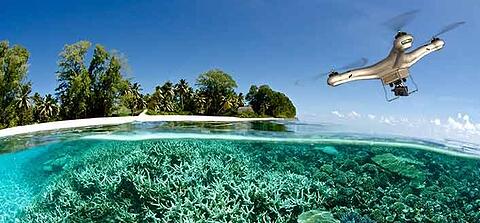The Great Barrier Reef and other large coral reef systems like it are considered to be the rainforests of the sea. According to the International Coral Reef Initiative, reefs support an estimated 25% of all marine life. They provide spawning, nursery, refuge, and feeding areas for a large variety of organisms that help sustain our planet. Coral reefs also protect coastlines from storms and erosion, are a source of food and new medicines, and contribute to local economies through tourism and scientific research. According to a 2013 study by the National Oceanic and Atmospheric Association, coral reefs contribute more than $3.4 billion to the US economy alone.
When water temperatures rise, coral polyps expel the algae that live symbiotically inside their tissues, resulting in the coral being stripped of their color, which is referred to as coral bleaching. Since algae produces oxygen and carbohydrates that are the main source of food for the coral, bleached coral quickly begins to starve. While some coral recover when water temperatures decrease, the sustained high temperatures caused by climate change are leading to more frequent bleaching events, which significantly increase the chance of permanent damage to the reefs. According to a UNESCO study, if current carbon emissions trends remain steady, widespread coral bleaching will occur in reefs twice every decade until 2044, when they will become an annual occurrence.
With so many marine organisms and economies depending upon the continued health of these coral reefs, action must be taken to reduce the scope and severity of these bleaching events. Achieving this goal begins with gaining a better understanding of the coral bleaching problem and raising public awareness of the existential threat it poses to these ecosystems.
Using Drones to Collect Bleaching Data
While the environmental catastrophe of coral bleaching will be difficult to solve, progress is being made toward understanding the problem. The Queensland University of Technology (QUT), in partnership with Microsofts AI for Earth program, has launched an effort to monitor the health of the Great Barrier Reef using drone technology, artificial intelligence (AI), and the Internet of Things (IoT).
Current methods of monitoring the health of coral reefs amount to either in-water surveys or satellite imagery. However, both of these methods encounter roadblocks that make it difficult to analyze the data that they gather; in-water surveys capture a limited amount of information, and satellite data is hard to decipher due to its low resolution and interference from cloud cover in overcast weather. The QUT has attempted to find a happy medium between these two methods by designing a drone that flies below the clouds and captures data through hyperspectral cameras.
Where a standard camera detects images in three bands of the visible spectrumred, green, and bluea hyperspectral camera uses 270 bands of the visible and near-infrared spectrum to identify and determine both the type of coral and the precise levels of coral bleaching present in its scanned area. This information then is uploaded to a cloud-based IoT management platform in real time for analysis, which can help pinpoint locations where the threat to coral reefs is the greatest. In comparison to the roughly 40 data points collected by in-water survey images, a single hyperspectral image can capture thousands of data points about a particular area of coral using AI and machine learning processes, without being hindered by clouds or any other limits that are present when using satellites. With this broader and more granular understanding of the coral bleaching problem, climate and marine scientists can petition governments and encourage the public to advocate for a data-driven plan of action to save coral reefs.
It Will Take Combined Action to Save Coral Reefs
QUTs project is only one of many that are trying to mitigate the symptoms of climate change. However, while the Internet of Things and its related technologies are powerful tools that can help aid in understanding the problem, they are only tools. For the damage of coral bleaching and other climate change side effects to be reversed, the threat must be taken seriously and receive proper funding from both public and private organizations around the world.
When it comes to developing IoT tools to understand the coral reefs climate change plight, Aeris stands ready to help. The Aeris Intelligent IoT Network provides a single-pane, top-down view of all connected devices within an IoT system, along with the tools to administer devices throughout their lifecycle. For projects like QUTs drone program, this level of insight enables a powerful asset management solution that is both customizable and scalable to fit the scope of the project.
To learn more about how IoT connectivity could help us understand the effects of climate change and spur action to reduce, reverse, and prevent further harm to delicate ecosystems, contact Aeris today.




